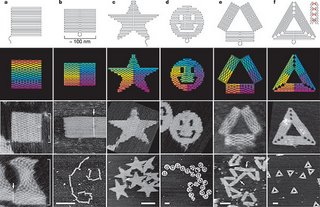Nano-Breadboards -- Grow Your Own!

The Scientific Activist: Reporting from the Crossroads of Science and Politics: Genetic Engineering's Next Challenge: The Smiley Face
The terrific blog, Scientific Activist reported on March 19 on an article in the journal Nature
by Paul Rothemund of Caltech, details a simple but apparently effective technique of designing and building virtually any two-dimensional shape using one long strand and several short pieces of DNA.
The method is fairly straightforward, and after a few planning steps nature takes care of the rest. After the desired shape has been chosen, the shape is conceptually filled in with rows of parallel DNA double helixes. The next step involves mapping one long single strand of DNA onto this template so that it zigzags over the entire surface, providing the shape with a great deal of stability. This piece of DNA is only single-stranded, though, so short pieces of DNA are then designed to be complementary to specific pieces of this long strand completing the double helixes. These pieces provide additional cross-links as well. After the DNA has been designed and manufactured, the individual pieces just have to be mixed together, and they’ll self-assemble into the desired shape, whatever that may be.
The smiley face and so forth in the third row above are actually constructed of DNA strands in the method explained above, and photographed with a scanning electron microscope. If you follow the link in the title, they have many more images: stars, rectangles, even pixels created with these strands of DNA to create the words, DNA repeating over and over. Just amazing to me! Beyond the sheer cuteness of it all (imagine designer DNA messages for loved ones with scanning electron microscopes!), this really leads to some pretty exciting future applications.
Think about being able to use the DNA to grow computer chips of incredible tininess. You could lay down the thinnest connections imaginable, and yet they would be more reliable than anything humans or robots could solder. You can use this method to design any 2-dimensional layout. There may eventually be a way to use it for 3 dimensions, which is what Nick is thinking at the S.A. blog -- he has written about folding proteins. That would be another step to create automatic 3-D designs. Wow!
No comments:
Post a Comment